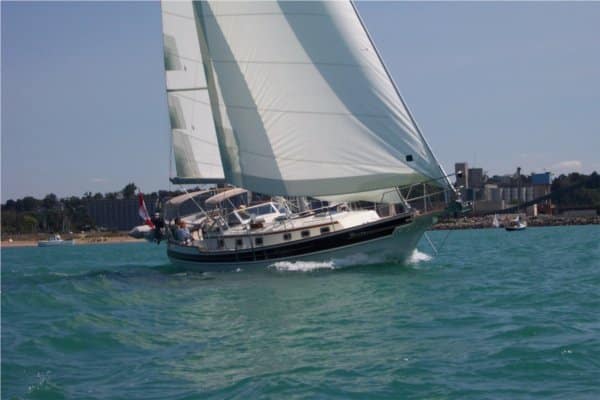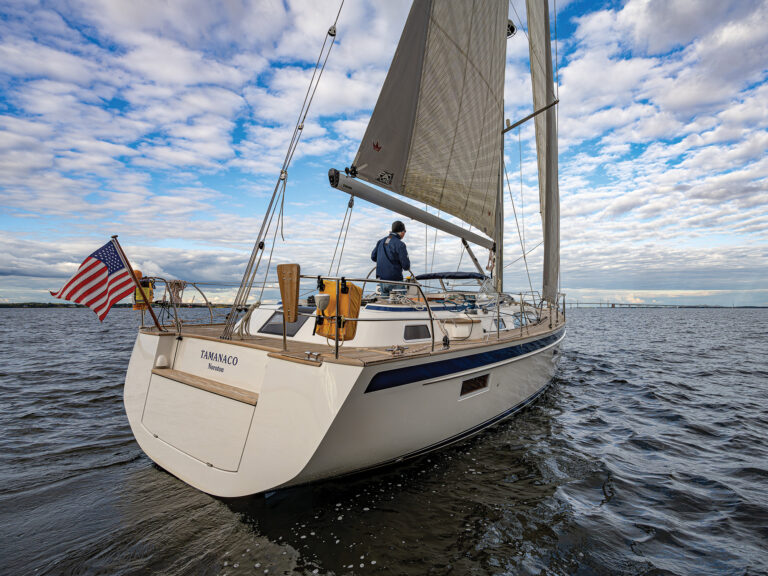
Setting out on the Gozzard 41 for a sail on Chesapeake Bay last fall, I knew almost instantly that this was my kind of boat. With a cruiser-friendly hull and deck plan, a pragmatic yet creative interior, and sensible onboard systems, the Gozzard 41 reflects traditional virtues often lost in pursuit of the Next Big Thing. Because I also happen to like clipper bows, raised quarter rails, and heart-shaped transoms, I also might add that the Gozzard is a very good-looking boat.
The product of what is truly a family business in Ontario, the Gozzard 41 is the latest evolution of the popular Gozzard 36, introduced in 1984. Since leaving the now-defunct Bayfield Boat Yard in 1981, designer Ted Gozzard has been constantly refining his version of the ideal voyaging liveaboard. His son, Mike, the production manager at Gozzard, oversees the onboard-systems and construction details, where the semicustom 41 shines. The boat is also available in a pilothouse version.
After spending a day riding gusty 15-knot breezes on the Chesapeake with my wife, Theresa, and the boat’s owners, Barbara and Andy Heath, I had only two regrets. One was that the ocean, the true arena for such a boat, was beyond our reach. The other was that this boat wasn’t mine. The helm responded naturally on all points of sail, and under the full-battened main, 130-percent genoa, and a generously proportioned staysail, she showed surprising power. This is a no-nonsense boat that will make comfortable progress when sailed full and by into a building sea, but she’ll quickly discipline an incurable sail tweaker inclined to pinch. The ride was so agreeable on a close reach that we abandoned plans for a lunch stop, broke out the sandwiches, and left our drinks untended on the steering console as the water rushed under the keel.
Although the boat’s underbody is a fairly conservative fin keel and skeg-hung rudder, Mike Gozzard says they’ve used strong, lightweight composites “to put the boat on a diet.” Her sail area-to-displacement ratio of 18.64 suggests sufficient canvas for moderate to light airs, and should the wind grow feeble, you’ve got 71 horsepower and 88 gallons of diesel fuel (more at the owner’s requests) at your disposal. When the time comes to short-tack up a channel or claw off a lee shore in a blow, the self-tacking staysail and its arced sheeting track allow for a good angle of attack. As a matter of preference, I’d choose a hank-on staysail rather than roller furling, and I’d invest in a good storm jib. (See “In Praise of the Versatile Staysail,” May 2002.)
The pull-pull steering using sheathed cables was smooth and efficient. The standard autopilot, an Autohelm 7000, connects directly to the steering quadrant, providing backup should a cable fail. Should both the autopilot and cable go kaput, a perfectly suitable emergency tiller is at the ready in the seat-locker lid. That said, our Boat of the Year judges regard the pull-pull cable system as less desirable than the usual cable-and-sheave arrangement (in which the exposed cable more readily lends itself to inspection, maintenance, and repair), direct-drive steering, or hydraulic steering. Mike Gozzard says that at the owner’s request, the 41 can be fitted with a hydraulic or a cable-and-sheave steering system. However, he regards a properly installed pull-pull system—which Gozzard has used for over 20 years—as an improvement over the usual cable-and-sheave arrangement.
Under power, the boat performs as expected, given her displacement and underbody. Reverse introduces noticeable prop walk, an inevitable trade-off for having a full-length skeg protecting the rudder and a large, three-bladed prop—both of which are in line with the boat’s philosophy. The 41 comes with a Westerbeke 71C4 rated at 71 horsepower at 3,600 rpm. Our test boat cruised comfortably and quietly at 6.6 knots at 2,800 rpm.
What I liked most about the boat is that when there’s a compromise to be made, Gozzard leans toward the side of safety, comfort, and reliability. It’s a realistic approach, tinged with a healthy dose of skepticism, that assumes nothing should be left to chance. A good example is the main-boom sheeting arrangement. The Gozzard’s mainsheet connects at the boom end, where the load belongs, and leads through a 3:1 purchase to a winch on the cockpit console, within easy grasp of the helmsman. The setup precludes a mainsheet track, but a Forespar rigid boom vang sufficiently controls mainsail twist.
Built to Last
As pretty as the Gozzard 41 is, it’s a forgiving boat, designed to take some abuse. Hull integrity has been one of Ted Gozzard’s hallmarks since his days at Bayfield, and the sandwich construction of the 41 is no exception. Layers of double-bias E-glass cloth and mat (with an outer-skin about 1/4-inch thick above the waterline and 5/16-inch thick below the waterline) are bonded on either side of 3/4-inch 550 Corecell, a linear polymer foam core that ranked high in U.S. Navy tests for strength and impact resistance. Solid glass laminate replaces coring material at the sheer line, centerline, keel, rudderpost, and all through-hulls. Thickness is added to the outer skin at the bow, trailboard, chainplate, mast step, and transom. The deck is equally robust, with core thickness up to 1 inch and solid laminate in place of core at any deck penetrations for hardware. The hull/deck joint is bedded in 3M 5200 and through-bolted with 316 stainless-steel machine screws at 6-inch centers. A varnished teak caprail (segmented for easy repair) creates an independent seal for the hull/deck joint, virtually eliminating any chance of a leak. Built to withstand a grounding or collision with flotsam, the rugged rudder and skeg assembly—both reinforced by internal stainless-steel frameworks—provide exceptional protection to the propeller and steering components.
On Deck
One only has to take a seat in the cockpit to appreciate the Gozzard’s deck plan. The 8-inch-high coaming extends to the outboard rails, opening up a comfortable working area in the cockpit. The increased beam allows room for the center console, a versatile addition where the steering wheel, engine controls, and electronic displays mount.
The practicality of the permanent windscreen is crystal clear—so to speak. Even in the tropics, dodgers rarely go down, and toughened glass affords far better visibility and durability than clear plastic. A small canvas dodger extends protection over the companionway, and an easily managed bimini top shields the helmsman without obstructing his view of the mainsail. For full shade while the boat is motoring or at anchor, more canvas zips in to fill the gap between the dodger and bimini. When the monsoon season descends, optional side panels create an all-weather addition on deck.
In addition to the 300-pound-capacity davits—handy in coastal waters—Gozzard includes padeyes on the foredeck to secure the dinghy for offshore passages. Convenient fold-down stairs at the transom lead to the water, or to the dock if you’re moored stern to. If a wave dares to rush over the 4 feet of freeboard aft, the cockpit is self-bailing through an 8- by 18-inch spring-loaded freeing port in the transom. A high bridgedeck guards the companionway, which has slots provided for storm boards.
Two short steps bridge the transition from the cockpit to the main deck. Rock-solid stanchions bolted to the inner side of the bulwarks, handholds along the coachroof, and 31-inch-high lifelines offer reassurance on a rolling deck. Padeyes for jacklines are standard. A forward storage locker, accessible through a Lewmar hatch, is divided: The forward section is for chain and rode storage, the afterpart, for sails and fenders. A bulkhead isolates this self-draining locker from the rest of the boat.
The 6-foot bowsprit, featuring a sturdy, 23-inch-wide pulpit, extends the foretriangle to make room for an efficient staysail and carries two bow anchors in bronze rollers at its end. A bowsprit can make docking exercises tricky, but the Gozzard’s sprit is clearly visible to the helmsman, even when he’s seated. Any docking misjudgments will be countered by the rubrails that run the length of the boat. These, as well as the caprail forward of amidships, are protected with stainless-steel rubstrakes. As the Heaths’ first cruising boat, the Gozzard will provide peace of mind during a blow or bolster confidence when maneuvering in tight corners.
Belowdecks
Unlike many boats that aim for a wider market and so sacrifice space for unnecessary berths or extra heads, the Gozzard’s imaginative layout is tailored for two people cruising and living aboard. This is a semicustom boat, so the builder is happy to modify interior details to suit individual needs. Any unclaimed corner, Gozzard’s carpenters turn into useful storage. There’s a double berth aft to port, with standing room, drawers, and a hanging locker as you enter. It makes a fine sea berth, but clearance above much of the sleeping area is about 24 inches, making the spacious forward berth/saloon a preferable place for a couple to sleep when the anchor sets.
I particularly like the boat’s clear run fore and aft—no corners to turn, no steps to descend. Ventilation on the boat is excellent, with all the right openings where you need them. The head and shower are to starboard, just below the companionway. Forward of the head is a comfortable navigation station that has an ample chart table as well as plenty of space for display monitors.
The galley drew very high marks from Theresa, who, after spending 11 years in front of a recalcitrant Shipmate stove, suddenly became wistful. A shiny Force 10 swings athwartship on lockable gimbals. The double sink lies well inboard, with both freshwater and saltwater faucets and a foot pump to back up the electric pressure pump. The top-loading freezer is thoughtfully equipped with a pneumatic hinge, so it stays open while you dig for freeze pops. The fridge below makes efficient use of cold air spilling from the freezer, and its door swings fore and aft, preventing an avalanche when you reach for a cold one during a passage.
The key to the Gozzard’s clever interior is the comfortable, athwartship dinette adjacent to the galley. The layout allows for a spacious area forward that readily morphs to suit your needs—an entertainment den, port and starboard sea berths, a separate double berth, or a larger dining area. With a wine rack, a huge locker forward, and enough bookshelf to fit a year’s worth of rainy-day reading, there’s no shortage of storage space up front. The Heaths requested a file drawer (funny how paperwork seems to follow you, even at sea), which fits nicely into the scheme. The versatile, airy layout offers a refreshing alternative for a cruising pair.
Beneath the fine joiner work and cherry interior is a boat built for the real world, with louvered cabinet doors for ventilation, sole panels that lock down, and adjustable hinges that allow for the wood’s natural expansion and contraction. In most places, access to wiring and through-bolts is easy through removable overhead panels and hull lining. Where access is tight, backing plates are threaded and bonded in place so that you can still easily remove the attached fitting for servicing or rebedding.
Systems Dissected
Despite my inclination toward cedar-bucket simplicity, I couldn’t fault the Gozzard for catering to a more civilized crowd, and I was won over by the fact that nearly all the systems are backed by redundancies. The mechanic has good access to all service points on the engine, although a special tool (provided) is needed to change the oil filter. Gozzard says the entire engine can come out in less than four hours without damaging any part of the boat. All tanks and batteries are securely mounted low in the hull. Gozzard has taken trouble to meet the difficult grounding requirements for lighting protection, including tying all rigging, the mast, and stanchions into ground plates to protect against side flashes.
Supplied by a 70-gallon main tank and an 18-gallon day tank (both made of aluminum, with epoxy coating to resist corrosion), the self-polishing fuel system virtually eliminates any chance of contaminants reaching the engine. Every tank has access panels in the top for cleaning. The 12-volt-DC electrical system has a dedicated absorbed-glass-mat starting battery plus rugged 2-volt cells grouped into two banks for a total of up to 900 amp-hours (600 amp-hours is standard) to supply house circuits. A 190-amp high-output alternator handles charging monitored by a Heart Interface LINK 2000R. A Freedom inverter/charger provides up to 2,000 watts of AC power at sea and a full charge at the dock. A separate AC distribution panel tends to your 120-volt needs.
Equipped to voyage, the boat has three separate water tanks, for a total of up to 175 gallons (150 gallons is standard), more than enough for an ocean crossing. The tanks’ vents have shutoff valves to prevent seawater contamination in washing-machine seas. The standard holding-tank size is 40 gallons. All seacocks are Marelon, eliminating any risk of electrolysis there.
I was still poking around for signs of neglect when our afternoon sail wound to a close. As one would expect of a family-built boat, this one shows uncommon pride in workmanship. I couldn’t help but feel a pang of envy. The Heaths had recently taken early retirement and were coast-hopping southward ahead of the winter chill. I would be back behind my computer in less than a day. They sent me an e-mail from the Bahamas in February. None to my surprise, they said they and their Gozzard were doing just fine. Some folks just have to rub it in.
Darrell Nicholson is a Cruising World associate editor








